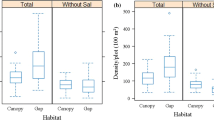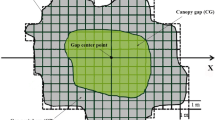Abstract
The tree community of both canopy gaps and mature forest was surveyed in a 5 ha plot of cloud forest in the Ibitipoca Range, south-eastern Brazil, aiming at: (a) comparing the tree community structure of canopy gaps with that of three strata of the mature forest, and (b) relating the tree community structure of canopy gaps with environmental and biotic variables. All saplings of canopy trees with 1–5 m of height established in 31 canopy gaps found within the plot were identified and measured. Mature forest trees with dbh ≥3 cm were sampled in four 40×40 quadrats laid on the four soil sites recognised in the local soil catena. All surveyed trees were identified, measured and distributed into three forest strata: understorey (<5 m of height), sub-canopy (5.1–15 m) and canopy (15.1–30 m). The following variables were obtained for each gap: mode of formation, age, soil site, slope grade, size, canopy openness and abundance of bamboos and lianas. A detrended correspondence analysis indicated that the tree community structure of gaps in all soil sites was more similar to that of the mature forest understorey, suggesting that the bank of immatures plays an important role in rebuilding the forest canopy and that gap phases may be important for understorey shade-tolerant species. There was evidence of gap-dependence for establishment for only one canopy tree species. Both canonical correspondence analysis and correlation analysis demonstrated for a number of tree species that the distribution of their saplings in canopy gaps was significantly correlated with two variables: soil site and canopy openness. The future forest structure at each gap is probably highly influenced by both the present structure of the adjacent mature forest and the gap creation event.
Similar content being viewed by others
References
Abe, S., Masaki, T. & Nakashizuka, T. 1995. Factors influencing sapling composition in canopy gaps of a temperate deciduous forest. Vegetatio 120: 21–32.
Arriaga, L. 1988. Gap dynamics of a tropical cloud forest in N. E. Mexico. Biotropica 20: 178–184.
Ashton, P. S. 1990. Species richness in tropical forests. Pp. 239–251. In: Holm-Nielsen, L. B., Nielsen, I. C. & Balslev, H. (eds), Tropical forests -botanical dynamics, speciation and diversity. Academic Press, London.
Augspurger, C. K. 1984. Seedling survival among tropical tree species: interactions of dispersal distance, light gaps, and pathogens. Ecology 65: 1705–1712.
Barton, A. M. 1984. Neotropical pioneer and shade-tolerant tree species: do they partition treefall gaps? Tropical Ecol. 25: 196–202.
Bourgeron, P. S. 1983 Spatial aspects of vegetation structure. Pp. 29–47. In: Golley, F. B. (ed.), Ecosystems of the world 14A -Tropical rain forest ecosystems, structure and function. Elsevier, Amsterdam.
Brokaw, N. V. L. 1985. Tree falls, regrowth and community structures in tropical forests. Pp. 53–59. In: Pickett, S. T. A. & Whitte, P. S. (eds), The ecology of natural disturbances and patch dynamics. Academic Press, Orlando.
Brokaw, N. V. L. 1982. The definition of tree fall gaps and its effects on measures of dynamics of forest. Biotropica 14: 158–160.
Brokaw, N. V. L. & Scheiner, S. M. 1989. Species composition in gaps and structure of a tropical forest. Ecology 70: 538–541.
Brown, N. D. 1993. The implications of climate and gap microclimate for seedling growth conditions in a Bornean lowland rain forest. J. Tropical Ecol. 9: 153–168.
Brown, N. D. & Whitmore, T. C. 1992. Do dipterocarp seedlings really partition tropical rain forest gaps? Phil. Trans. Roy. Soc. London B335: 369–378.
Clark, D. B., Clark, D. A. & Rich, P. M. 1993. Comparative analysis of microhabitat utilization by saplings of nine tree species in neotropical rain forest. Biotropica 24: 397–407.
Dalling, J. W., Hubbell, S. P. & Silvera, K. 1998. Seed dispersal, seedling establishment and gap partitioning among tropical pioneer species. J. Ecol. 86: 674–689.
Denslow, J. S. 1980. Gap partitioning among tropical rain-forest trees. Biotropica 12: 47–55.
Denslow, J. S. 1985. Disturbance-mediated coexistence of species. Pp 307–323. In: Picket, S. T. A. & White, P. S. (eds), The ecology of natural disturbance and patch dynamics. Academic Press, New York.
Denslow, J. S. 1987. Tropical rainforest gaps and tree species diversity. Annu. Rev. Ecol. Systems 18: 431–451.
Denslow, J. S., Schultz, J. C., Vitousek, P. M. & Strain, B. R. 1990. Growth response of tropical shrubs to treefall gap environments. Ecology 71: 165–179.
Denslow, J. S. & Hartshorn, G. S. 1994. Tree-fall gap environments and forest dynamics processes. Pp. 120–127. In: Mcdade, L. A., Bawa, K. S., Hespenheide, H. A. & Hartshorn, G. S. (eds), La selva: ecology and natural history of a neotropical rain forest. The University of Chicago Press, Chicago.
Denslow, J. S., Ellison, A. M. & Sanford, R. E. 1998. Treefall gap size effects on above-and below-ground processes in a tropical wet forest. J. Ecology 86: 597–609.
Devoe, N. N. 1992. Regeneration from seed under a range of canopy conditions in tropical wet forest, Puerto Rico. Pp. 81–100. In: Kelty, M. J. (ed.), The ecology and silviculture of mixed-species forests. Kluwer Academic Publishers, Amsterdam.
Doyle, T. W. 1981. The role of disturbance in the gap dynamics of a montane rain forest: An application of a tropical forest succession model. Pp. 56–73. In: West, D. C., Shugart, H. H. & Botkin, D. B. (eds), Forest succession: concepts and applications. Springer-Verlag, New York.
Falkenberg, D. B. & Voltolini, J. C. 1994. The montane cloud forest in southern Brazil. Pp. 138–149. In: Hamilton, L. S., Juvik, J. O. & Scatena, F. N. (eds), Tropical montane cloud forest. Springer-Verlag, New York.
Fontes, M. A. L. 1997. Análise da composiç ã o florística das florestas nebulares do Parque Estadual do Ibitipoca, Minas Gerais. Masters dissertation, Federal University of Lavras, Brazil.
Gentry, A. H. 1995. Patterns of diversity and floristic composition in Neotropical montane forests. Pp. 103–126. In: Churchill, S. P., Balslev, H., Forero, E., Luteyn, J. L. (eds), Neotropical montane forest biodiversity and conservation symposium, 1. The New York Botanical Garden, New York.
Gó mez-Pompa, A. & Vázquez-Yanes, C. 1981. Successional studies of a rain forest in Mexico. Pp. 246–266. In: West, D. C., Shugart, H. H. & Botkin, D. B. (eds), Forest succession: concepts and applications. Springer-Verlag, New York.
Hartshorn, G. S. 1978. Tree falls and tropical forest dynamics. Pp. 617–638. In: Tomlinson, P. B. & Zimmermann, M. H. (eds.), Tropical trees as living systems. Cambridge University Press, Cambridge.
Hartshorn, G. S. 1980. Neotropical forest dynamics. Biotropica 12: 23–30.
Hartshorn, G. S. 1990. Gap-phase dynamics and tropical tree species richness. Pp. 65–73. In: Holm-Nielsen, L. B., Nielsen, I. C. & Balslev, H. (eds), Tropical forests -Botanical dynamics, speciation and diversity. Academic Press, London.
Hope, A. C. A. 1968. A simplified Monte Carlo significance test procedure. J. Roy. Stat. Soc. B30: 582–598.
Hubbell, S. P. & Foster, R. B. 1986. Canopy gaps and the dynamics of a neotropical forest. Pp. 77–96. In: Crawley, M. J. (ed), Plant ecology. Blackwell Scientific, Oxford.
Kennedy, D. N. & Swaine, M. D. 1992. Germination and growth of colonizing species in artificial gaps of different sizes in dipterocarp rain forest. Phil. Trans. Roy. Soc. London B335: 357–366.
Kent, M. & Coker, P. 1992. Vegetation description and analysis, a practical approach. John Wiley & sons, New York.
Lawton, R. O., Putz, F. E. 1988. Natural disturbance and gap-phase regeneration in a wind-exposed tropical cloud forest. Ecology 69: 764–777.
Lieberman, M., Lieberman, D. & Peralta, R. 1989. Forests are not just swiss cheese: Canopy stereogeometry of non-gaps in the tropical forests. Ecology 70: 550–552.
Lieberman, M., Lieberman, D., Peralta, R. & Hartshorn, G. S. 1995. Canopy closure and the distribution of tropical forest tree species at La Selva, Costa Rica. J. Tropical Ecol. 11: 161–178.
Mccune, B. & Mefford, M. J. 1997. PC-ORD. Multivariate analysis of ecological data, version 3.0. MjM Software Design, Glaneden Beach, Oregon.
Martínez-Ramos, M. 1985. Claros, ciclos vitales de los arboles tropicales, y la regeneration natural de las selvas altas perennifolias. Pp. 191–239. In: Gomez-Pompa, A. & del Amo, S. (eds), Investigaciones sobre la regeneració n de selvas altas en Vera Cruz, Mexico. Vol. II. Alhambra, Mexico DF.
Oliveira-Filho, A. T. & Fontes, M. A. L. 1999. Patterns of floristic differentiation among Atlantic forests in south-eastern Brazil, and the influence of climate. Biotropica 31 (in press).
Oliveira-Filho, A. T., Vilela, E. A., Carvalho, D. A. and Gavilanes, M. L., 1994. Effects of soils and topography on the distribution of tree species in a tropical riverine forest in south- eastern Brazil. J. Tropical Ecol. 10: 483–508.
Orians, G. H. 1982. The influence of tree-falls in tropical forests in tree species richness. Tropical Ecol. 23: 255–279.
Putz, F. E. 1983. Treefall pits and mounds, buried seeds, and the importance of soil disturbance to pioneer tree species on Barro Colorado Island, Panama. Ecology 64: 1069–1074.
Runkle, J. R. 1982. Patterns of disturbance in some old-growth mesic forests of eastern North America. Ecology 63: 1533–1546.
Runkle, J. R., Stewart, G. H., Veblen, T. T. 1995. Sapling diameter growth in gaps for two Nothofagus species in New Zealand. Ecology 76: 2107–2117.
Swaine, M. D. & Whitmore, T. C. 1988. On the definition of ecological species groups in tropical rain forests. Vegetatio 75: 81–86.
Terborgh, J. 1992. Diversity and the tropical rain forest. Scientific American Library, New York.
ter Braak, C. J. F. 1987. The analysis of vegetation environment relationships by canonical correspondence analysis. Vegetatio 69: 69–77.
ter Braak, C. J. F. 1995. Ordination. Pp. 91–173. In: Jongman, R. H. R., Ter Braak, C. J. F. & Van Tongeren, O. F. R. (eds), Data analysis in community and landscape ecology. Cambridge University, Cambridge.
ter Steege, H. 1993. HEMIPHOT -a program to analyze vegetation indices, light and light quality from hemispherical photographs. The Tropenbos Foundation, Wageningen.
Turner, I.M. 1990. Tree seedling growth and survival in a malaysian rain forest. Biotropica 22: 146–154.
Uhl, C., Clark, K., Dezzeo, N. & Maquirino, P. 1988. Vegetation dinamics in amazonian treefall gaps. Ecology 69: 751–763.
van Tongeren, O. F. R. 1995. Cluster analysis. Pp. 174–212. In: Jongman, R. H. G., ter Braak, C. J. F. & van Tongeren, O. F. R. (eds), Data analysis in community and landscape ecology. Cambridge University Press, Cambridge.
Veblen, T. T. 1982. Growth patterns of Chusquea bamboos in the understory of Chilean Nothofagus forests and their influence in forest dynamics. Bull. Torrey Bot. Club 109: 474–487.
Veenendaal, E. M., Swain, M. D., Agyeman, V. K., Blay, D., Abebrese, I. K. & Mullins, C. E. 1995. Differences in plant and soil water relations in and arround a forest gap in West Africa during the dry season may influence seedling establishment and survival. J. Ecol. 83: 83–90.
Veloso, H. P., Rangel-Filho, A. L. R. & Lima, J. C. A. 1991. Classificaç ã o da vegetaç ã o brasileira, adaptada a um sistema universal. Instituto Brasileiro de Geografia e Estatística, Rio de Janeiro, Brazil.
Whitmore, T. C. 1978. Gaps in forest canopy. Pp. 639–655. In: Tomlinson, P. B. & Zimmermann, M. H. (eds.), Tropical trees as living systems. Cambridge University Press, Cambridge.
Whitmore, T. C. 1988. The influence of tree population dynamics on forest species composition. Pp. 271–291. In: Davy, A. J., Hutchings, M. J. & Watkinson, A. R. (eds), Plant population ecology. Blackwell, Oxford.
Whitmore, T. C. 1984. Tropical rain forest of the Far East. Clarendon Press, Oxford.
Zar, J. K. 1996. Biostatistical analysis. Prentice Hall, New Jersey.
Author information
Authors and Affiliations
Rights and permissions
About this article
Cite this article
de Carvalho, L.M.T., Fontes, M.A.L. & Oliveira-Filho, A.T.d. Tree species distribution in canopy gaps and mature forest in an area of cloud forest of the Ibitipoca Range, south-eastern Brazil. Plant Ecology 149, 9–22 (2000). https://doi.org/10.1023/A:1009836810707
Issue Date:
DOI: https://doi.org/10.1023/A:1009836810707




